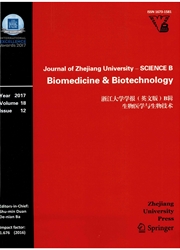

 中文摘要:
中文摘要:
内视镜后退 cholangiopancreatography (ERCP ) 是广泛地过去常诊断并且对待胆汁或胰腺的 ductal 的条件的一个过程系统。严重尖锐胰腺炎(树液) 与十二指肠穿孔伴随了的 post-ERCP 稀罕却严肃,仍然是在诊所的挑战。在这研究,我们报导二个如此的案例。二个中国女人为胆汁管阻塞的临床的怀疑被对待并且在承认以后经历了 ERCP。两个在 ERCP 以后开发了十二指肠穿孔和树液,并且在特别护理单位(ICU ) 被管理并且要求了器官失败支持。有伐木腹的复合切口并且手术后的洗和排水的仙子胰腺的清创术的外科的干预被执行,并且二个病人恢复了很好。有切口与在严重 post-ERCP-pancreatitis (锐气) 和十二指肠穿孔的病人的手术后的洗和排水相结合的伐木腹的化合物的仙子胰腺的清创术的治疗学的效果是令人满意的。关键词内视镜后退 cholangiopancreatography (ERCP )- Post-ERCP-pancreatitis (锐气)- 十二指肠穿孔 - 清创术 - 中国(号码 30801188 ) 的国家自然科学基础支持的排水 CLC 数字 R61 工程,和浙江省的自然科学基础,中国(Nos. Y2090443 和 Y2090460 )
 英文摘要:
英文摘要:
Endoscopic retrograde cholangiopancreatography (ERCP) is a procedure widely used to diagnose and treat conditions of biliary or pancreatic ductal system. The post-ERCP severe acute pancreatitis (SAP) accompanied with duodenum perforation is rare but serious, remaining a challenge in clinic. In this study we report two such cases. Two Chinese women were treated for clinical suspicion of bile duct obstruction and underwent ERCP after admission. Both developed duodenum perforation and SAP after ERCP, and were managed in the intensive care unit (ICU) and required an organ-failure support. The surgical intervention of the peri-pancreatic debridement with lumber-abdominal compound incisions and postoperative washing and drainage was performed, and the two patients recovered well. The therapeutic effect of the peri-pancreatic debridement with lumber-abdominal compound incisions combined with postoperative washing and drainage in the patients of severe post-ERCP-pancreatitis (PEP) and duodenum perfora- tion is satisfactory.
 同期刊论文项目
同期刊论文项目
 同项目期刊论文
同项目期刊论文
 期刊信息
期刊信息
